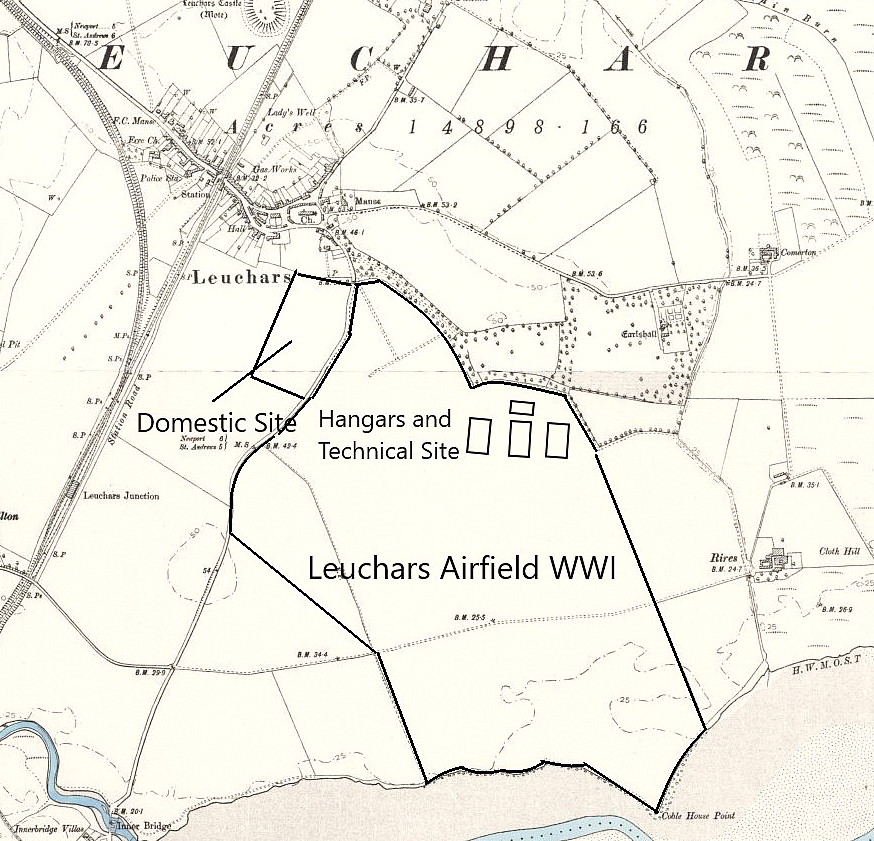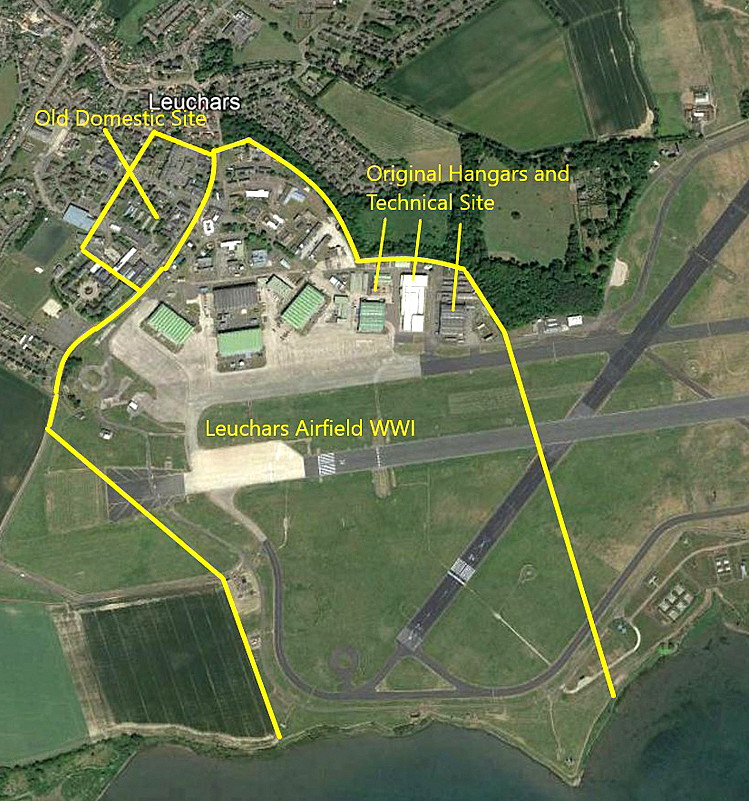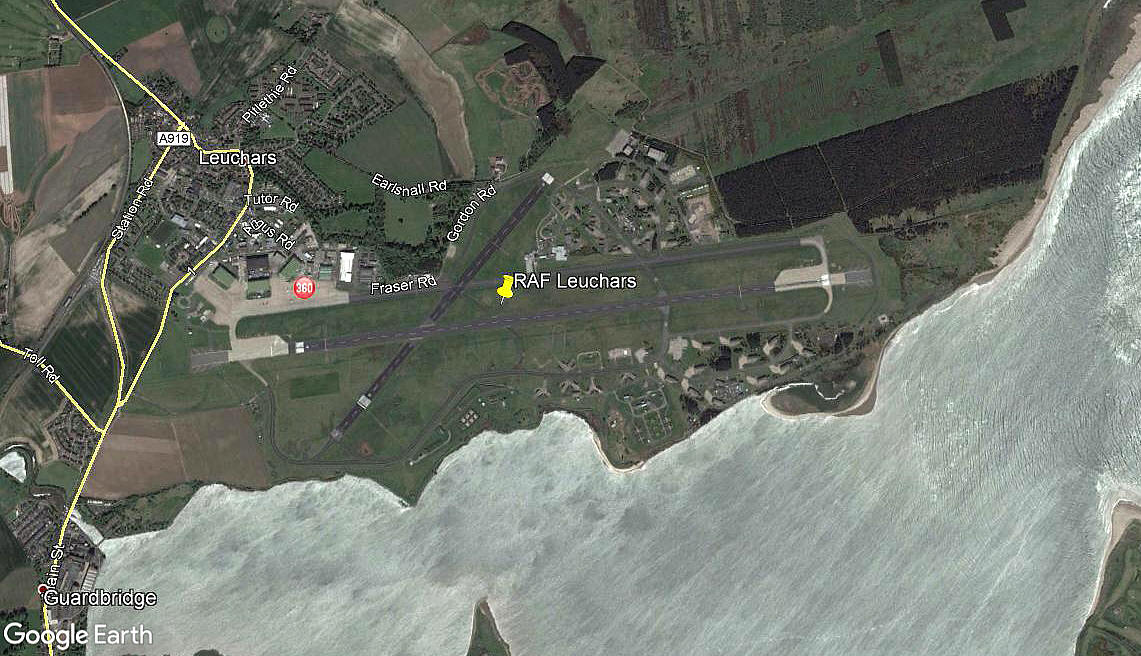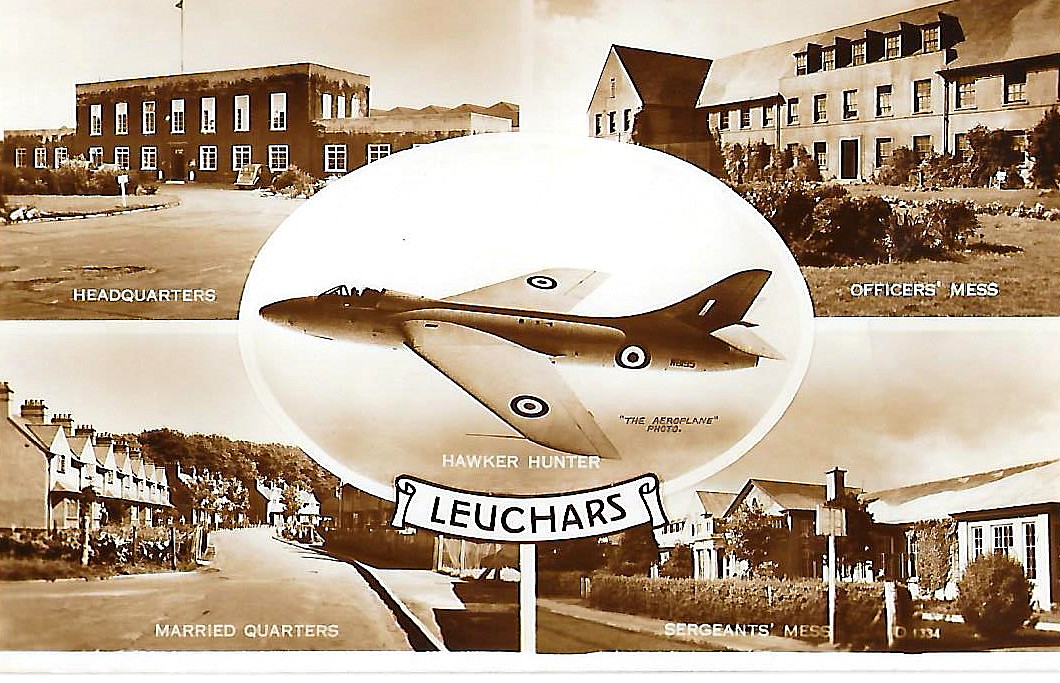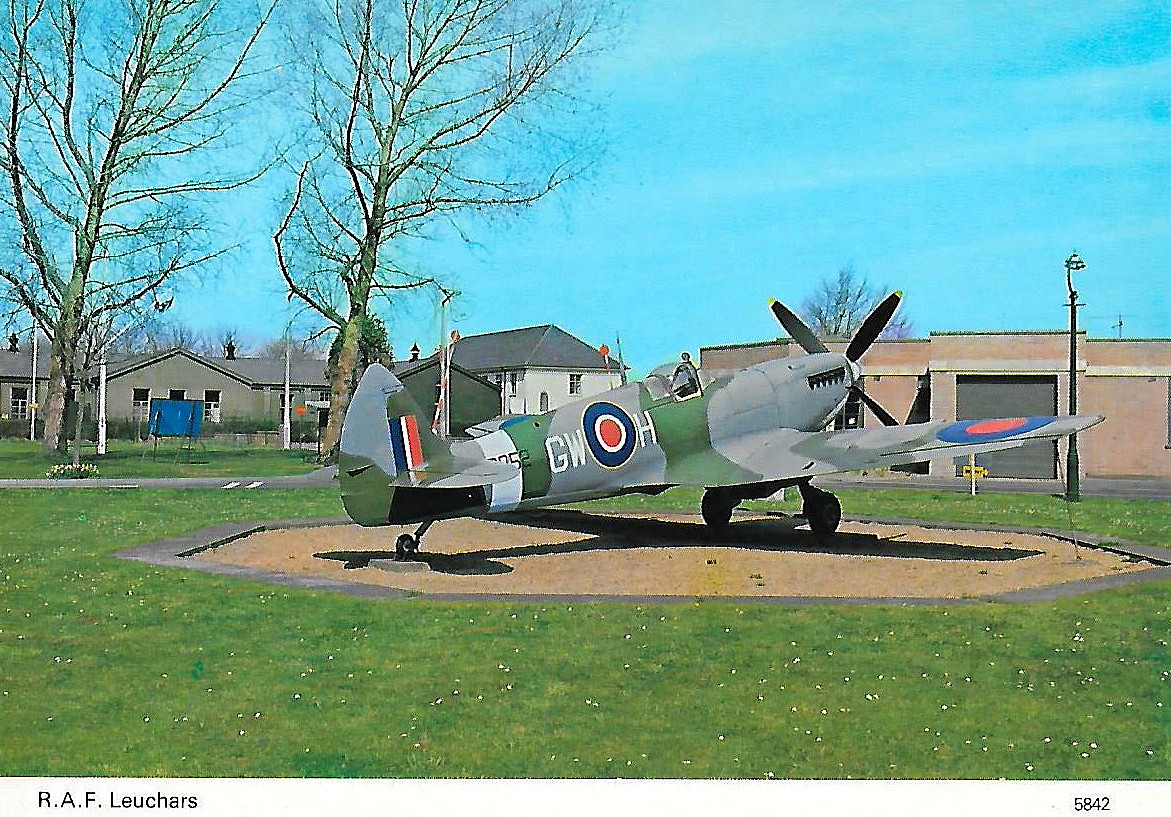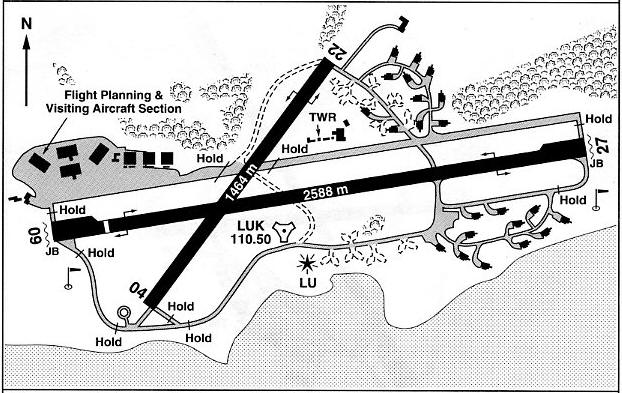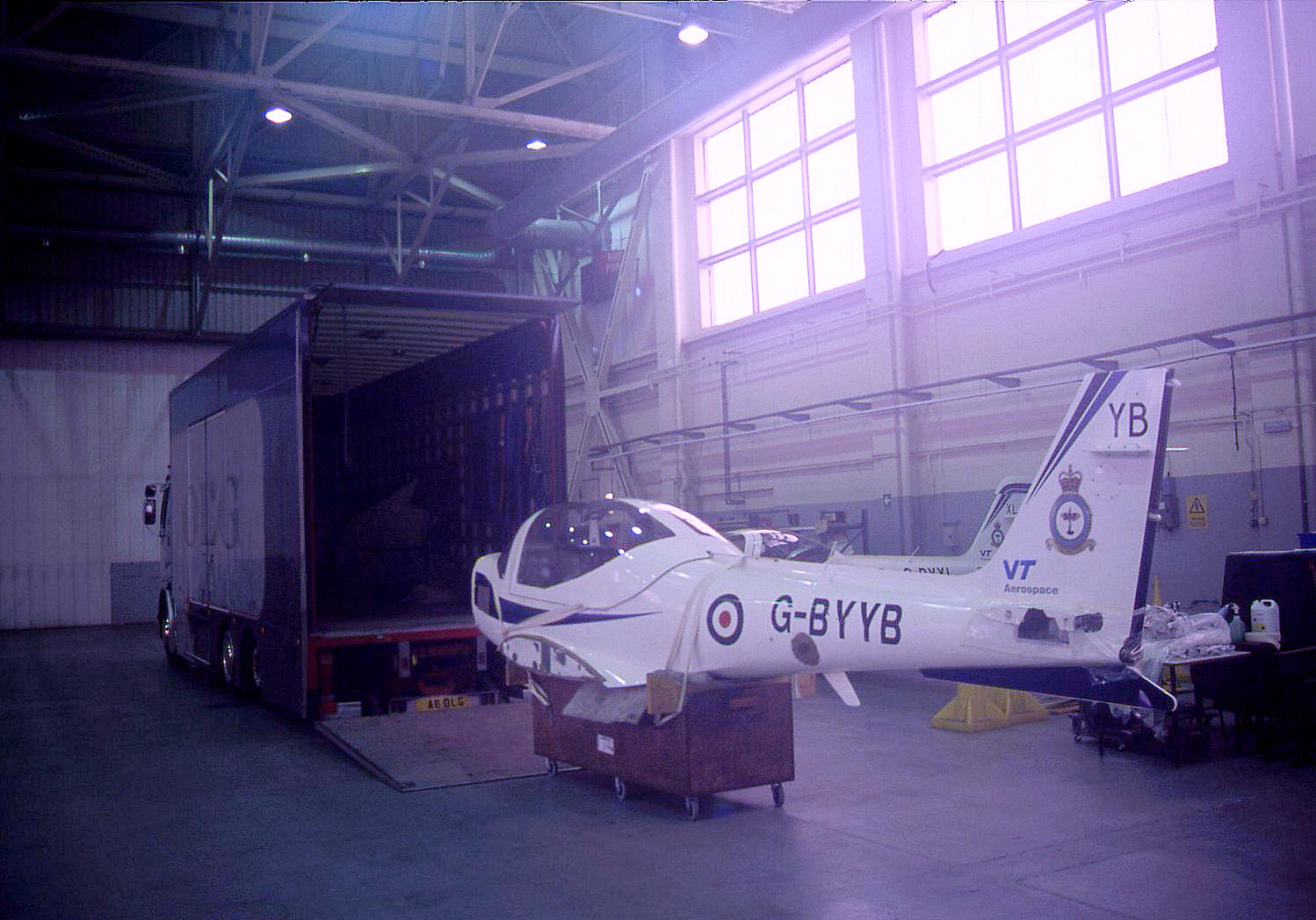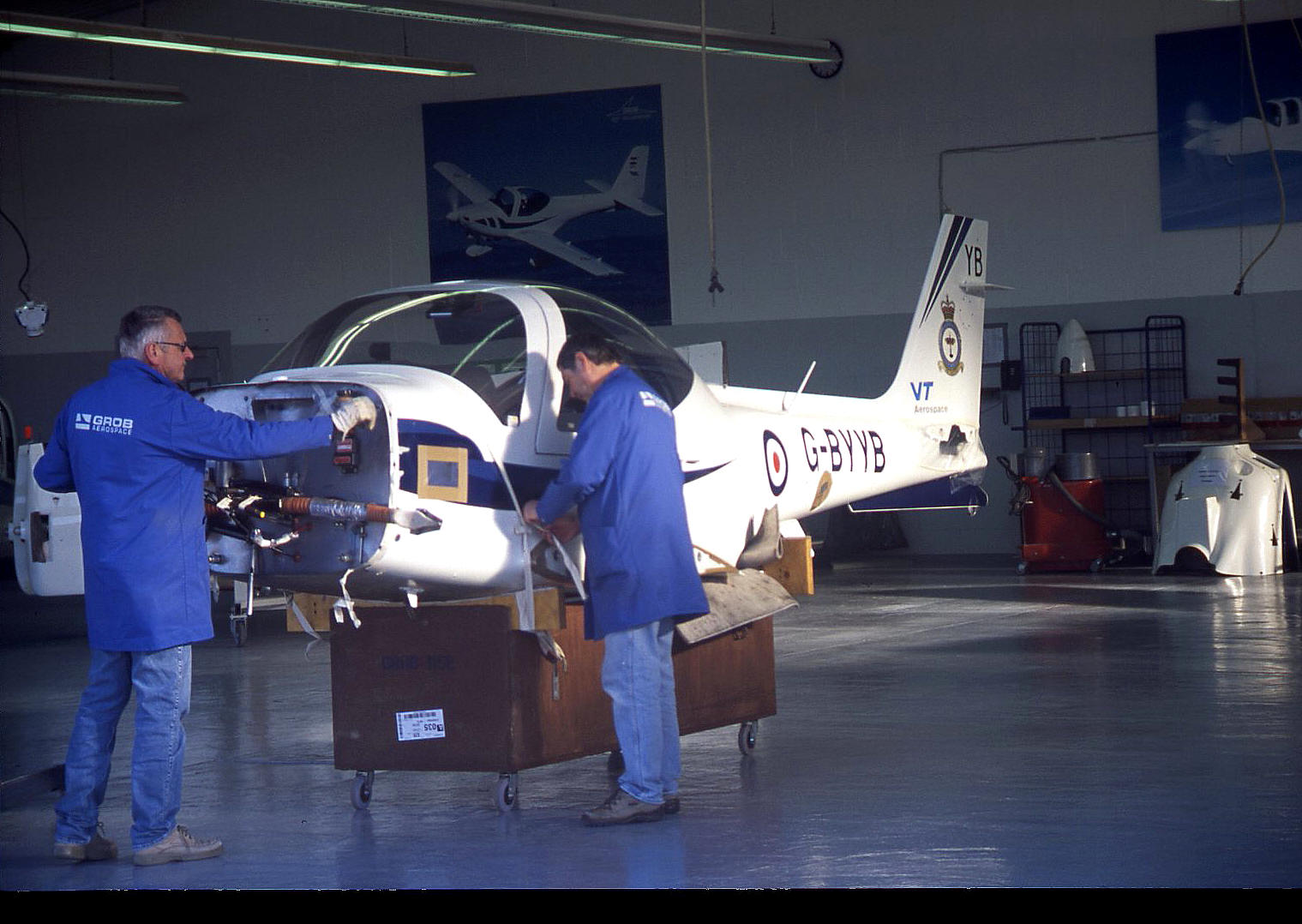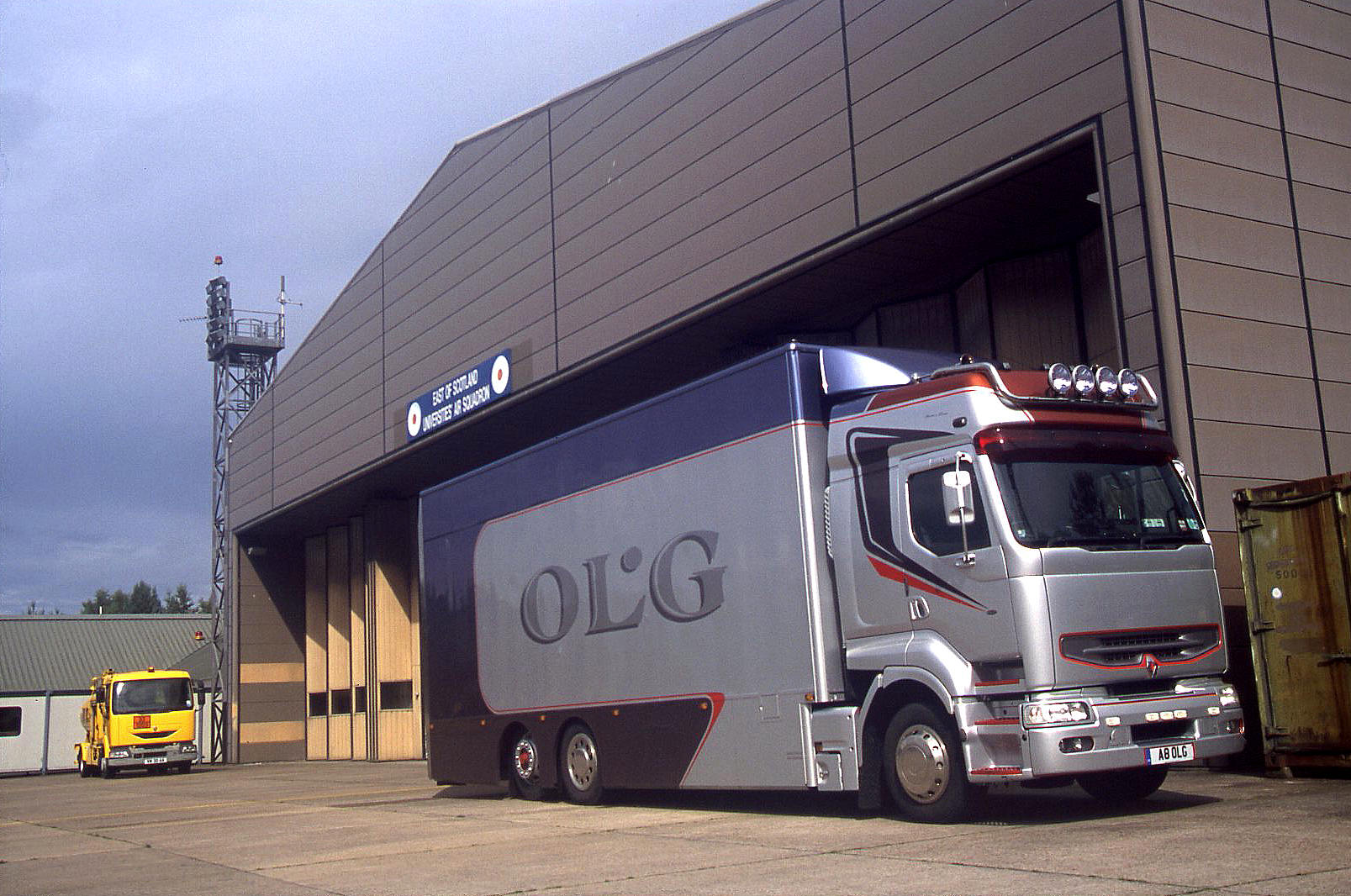Leuchars
LEUCHARS: Military aerodrome (In WW1 known as LEUCHARS JUNCTION)
Note: The first two items were kindly provided by Mr Michael T Holder. The third picture I obtained from Google Earth ©
Military users: WW1: RAF School and Ships’ Aeroplane Base
Pre 1940: Fleet Air Arm (Avro 504Ks) 406 Fleet Fighter Flight
441 & 442 Fleet Spotter Reconnaissance Flights
WW2: RAF Coastal Command 18 Group
RAF Bomber Command 2 Group
RAF Fighter & Training Commands
42 Sqdn (Bristol Beauforts)
105 Sqdn (DH Mosquitos)
107 Sqdn (Bristol Blenheims)
120 & 206 Sqdns (Consolidated Liberators)
224, 233, & 279 Sqdns (Lockheed Hudsons)
320 (Netherlands) Sqdn (Avro Ansons, later Lockheed Hudsons)
333 (Norwegian) Sqdn (Consolidated Catalinas later Mosquitos….an odd combination?)*
455 (Australian/RAAF) Sqdn (Bristol Beaufighters)
489 (New Zealand/RNZAF) Sqdn (Beauforts, Blenheims, Hampdens & Beaufighters)
540 Sqdn (De Havilland Mosquitos)
547 Sqdn (Vickers Wellingtons)
605 Sqdn (Hawker Hurricanes)
'A' Flight PRU (Photo Reconnaissance Unit) (PR Mosquitoes, possibly also PR Spitfires)
1 FTS
3 Armament Practise Camp (Westland Lysanders)
18 Group Comms Flt (Flying various types)
USAAF 1409th Army Air Force Base Unit
Note: Used for clandestine missions to Sweden as a staging post. See METFIELD (SUFFOLK) for a bit more information.
Post 1945: RAF Fighter Command
Note: These pictures from postcards were kindly sent by Mike Charlton who has an amazing collection. See, www.aviationpostcard.co.uk
The Spitfire TB252 served as a 'gate guardian' here from 1969 to 1986.
'V' Bomber dispersal airfield
151 Sqdn (DH Vampires, then Gloster Meteors, later DH Venoms. After a spell at TURNHOUSE (LOTHIAN) returning with Javelins
43(F) Sqdn (Meteors, Hunters, Phantoms & later Tornado F3s)
222 Sqdn (Meteors later Hunters)
151 Sqdn (Venom NF.3s)
111 Sqdn (Phantoms later Tornado F3s) 228 OCU (Phantoms)
22 Sqdn (Westland Wessex)
Aberdeen, Dundee, St Andrews & East Lowlands UAS (Bulldogs later Grob Tutors)
Army: 7 Regiment AAC (Volunteers) 3 Flight (Volunteers)
1975: (Lightnings, Phantoms & Whirlwind helicopters)
1998 snapshot: RAF Air Defence
43 Sqdn 13 x Panavia Tornado F3
111 Sqdn 13 x Panavia Tornado F3
1990/2000: RAF Military Emergency Diversion Aerodrome
2003/4: 8 Sqdn (Eurofighter Typhoon FGR.4s)
2013: East of Scotland Universities Air Squadron Grob 115 Tutors
Civil users: 1990s + : Typically private and executive jets attending golf tournaments at St Andrews
Location: 3.5nm NW of St Andrews
Period of operation: 1918 to -
Note: This map is reproduced with the kind permission of Pooleys Flight Equipment Ltd. Copyright Robert Pooley 2014.
Site area: WW1: 221 acres 1143 x 823
Runways: WW2: 09/27 1847x46 hard 04/22 11829x46 hard
1990/2000: 09/27 2588x46 hard 04/22 1464x46 hard
NOTES: * 333 Sqdn Catalinas were based at WOODHAVEN.
A STRIKE FORCE
This is the sort of thing that has fascinated me. After deciding to form a specific ‘Strike Force’ in late 1942 against enemy shipping, especially in the North Sea, with the first Wing being formed at NORTH COATES LINCOLNSHIRE with three squadrons of Beaufighters, (becoming operational in November 1942), as part of the strategy to ‘soften up’ the enemy supply chain by sea prior to the invasion of Europe; it wasn’t until March 1944 that the two-squadron strike wing of 455 (RAAF) and 489 (RNZAF) were formed here. And, after presumably becoming effective operationally they were then sent to LANGHAM, NORFOLK.
THE 'CINDERELLA' SERVICE
The massively important but often extremely tedious duties performed by Coastal Command in WW2, especially when seeking U-boats out in the Atlantic, rarely hit the spotlight of publicity, and there are two important facts regarding these operations which are rarely mentioned. It now appears that Coastal Command Consolidated Liberators sank ninety-three U-boats, and 120 Squadron based here accounted for nineteen. Perhaps a lesser appreciated factor was that when aircraft such as the Catalina, Liberator and Sunderland were on these patrols, when they were spotted it resulted in the U-boat immediately diving and therefore being unable to locate shipping.
There was of course no way that the crews of these aircraft could gauge such a result and I think it is correct that they did not realise their effectiveness until after the war ended. Another aspect, not too often mentioned, is that attacking a U-boat on the surface was a very dangerous affair indeed because, as the vessel was quite small, it was essential to maintain a straight line of attack, therefore affording the gunners on the submarine a constant aspect at which to aim at.
BOAC MOSQUITO MISSIONS
Possibly one of the most historically interesting and certainly very dangerous missions flown from LEUCHARS in WW2 concerns the regular flights through German occupied airspace to reach Stockholm (presumably Bromma airport?) in neutral Sweden flown by unarmed ‘civilianised’ Mosquitoes operated by BOAC. Sometimes passengers were carried, invariably mail too, but surely the main reason was flying back with loads consisting of precision ball bearings and machine-tool steel which were vital to the war effort.
Oddly as it might seem, these flights were mostly flown by Norwegian officers, who were nominally ‘civilian employees’ of BOAC. But at least one was British and he was Captain ‘Gibby’ Rae, who learnt to fly with the Scottish Flying Club at MOORPARK/RENFREW and his aircraft failed to return. Shaking off enemy attack using mainly just the sheer speed of the ‘Mossie’was a regular feature of these daring flights and although ostensibly civilian they were of course legitimate targets for the German defences.
Passengers (one at a time) were carried in a very basic manner, in the ‘bomb bay’ or rather cargo compartment. Probably the most important passenger was the Danish physicist Niels Bohr who, having a Jewish mother had fled to Sweden when the Germans invaded Denmark. He was world famous for foundation contributions to the understanding of atomic structures and quantum mechanics and was awarded the Nobel Prize in Physics in 1922. After being safely delivered to LEUCHARS in November 1943 Bohr joined the Tube Alloys nuclear weapons project. He later became part of the team of British physicists which contributed to the Manhattan Project in the USA which developed the first atomic bombs. It was of course the dropping of two atomic bombs, the first on Hiroshima and then the second on Nagasaki, which led to the Japanese surrender on the 2nd September 1945.
I think it is correct to think that for most if not all the scientists involved in the Manhattan project, the concept of the Cold War developing after WW2 was the exact opposite of what they thought they’d achieved. But once scientific advances have migrated from the laboratory into political and military arenas, the results are invariably bad news for humanity.
A SELF EDUCATION
One consequence of starting this Guide which I certainly hadn’t predicted, is that given time it leads to an appreciation of not only how aviation has developed, but also how society has changed. Plus numerous other educational advantages – mainly for myself of course. For example, I’m not entirely certain I had heard of Niels Bohr until I came across the mention of him being flown into LUECHARS so decided to trawl the web for more info – which exists in spades.
After WW2 Bohr was involved in other major nuclear scientific initiatives, not least the development of CERN which opened in 1954 on the French/Swiss border near Geneva. Today this vast and immensely important research establishment, supported by twenty European states, employs 2,400 people full-time, 1,500 part-time and hosts 10,000 visiting scientists from 608 universities, etc, etc.
But, what I had forgotten is that it was a British computer scientist, Tim Berners-Lee, then employed at CERN who developed the World-Wide Web concept between March 1989 and December 1990. I find this rather satisfying – to unexpectedly discover the history of the World-Wide Web. And indeed, in producing this Guide it has proved to be invaluable. And presumably you also are viewing this Guide on the web.
HUNTERS
No.43(F) Squadron were the first to operate the Hawker Hunter F.1 with deliveries commencing in July 1954 and replacing Gloster Meteor F.8s. As pointed out elsewhere (see WEST RAYNHAM, NORFOLK) it would appear that LEUCHARS was amongst the most inappropriate places in the UK to operate the Hunter F.1, given the very limited range of these first versions. It therefore seems even stranger that the RAF top brass decided to re-equip a second squadron based here, No.222 who had also been flying the Meteor F.8.
I suppose the question must now be asked as to why the Hunter F.1 and F.2 was ever allowed to enter front-line service as the much improved F.4 and F.5 variants followed on so soon afterwards. Such a colossal waste of money and effort! Robert Jackson in his excellent book Britain’s Greatest Aircraft also makes this interesting observation. “At the end of 1956 RAF Fighter Command had sixteen Hunter squadrons at its disposal, based on ten airfields from Leuchars in Scotland to Tangmere in Sussex.
Fighter Command’s general policy in the 1950s was to concentrate two day-fighter squadrons and one night-fighter squadron to form a single wing on an operational airfield; the Leuchars Wing, for example, comprised Nos 43 and 222 Squadrons, with Hunters, and No.151 Squadron with de Havilland Venom NF.3s. This policy was to remain in force until the early 1960s, when the squadrons of Fighter Command began to receive an integrated all-weather weapons system in the form of the English Electric Lightning.”
There is something about this deployment of Hunter squadrons which confuses me. Given that the only perceived threat was from the Soviet Union in the 1950s, why base fighters at LEUCHARS? Regarding LEUCHARS my first thought was that this would provide cover for the nuclear submarine base at Faslane in the Firth of Clyde. Except that the first British nuclear submarine was HMS Dreadnought launched in 1960 and Faslane didn’t become operational until 1964. So, what exactly was RAF LEUCHARS defending, of great importance, in the event of an all out nuclear war? I suppose the obvious answer was the naval base at Rosyth but would this have figured as a priority target in such circumstances?
But of course, I suppose, I am ignoring the ship building industry on the Clyde? Then again, quite what use this would have been given that the population of the UK would have been mostly wiped out in the first day escapes me. As said elsewhere, just as in early WW2, it was a numbers game, and, if the opposing force throws enough bombers – many will get through - and the Soviets certainly had the numbers.
QUICK REACTION ALERT
At main RAF fighter/interceptor stations, (such as LEUCHARS), since the ‘Battle of Britain’ in WW2 really, and still the case even today it appears, a number of aircraft and crews are on QRA duty. The aircraft are fuelled and armed, the crews on stand-by but positioned close to the aircraft, and ready to be scrambled at a moments notice – 24 hours a day, 365 days a year. I believe in the Cold War, (still the case today?), it was reckoned to get the aircraft airborne in less than fifteen minutes and as little as two minutes at times of heightened alert. This state of affairs also existed at ‘V-bomber’ bases during the Cold War.
A PERSONAL MEMORY
In July 2008 I was given the job of moving the Grob G115E Tutor (G-BYYB) from LEUCHARS to the Grob factory in Tussenhausen-Mattsies in Bavaria, Germany. Over the years I transported several Tutors for repair to Grob in Germany, but this trip was over the longest distance. I was quite lucky in that a ferry still ran from Rosyth, (near Edinburgh) to Zeebrugge in Belgium, and in my opinion the best way of driving a truck across the North Sea is to be propping up the bar on a ferry.
The third picture shows my truck parked outside of the East of Scotland Universities Air Squadron hangar. As you might well imagine, coming from a reggie spotter background at London Airport in my early teens in the 1960s, to then find myself over half a century later moving aeroplanes and sometimes driving onto major RAF air bases, such as RAF LEUCHARS, was always a great pleasure.
margaret aitken
This comment was written on: 2017-10-07 09:25:36This is interesting, and I feel a certain link with Leuchars - on a personal basis I am searching for recors for Leuchards Aerodrome in WW1, when it was a training facility and, specifically, I am looking for records of American Expeditionary Force trainees. Any thoughts? Contnuing on the prsonal note, it is sad to see the old lave no longer used for flight after such a proud tradition, and having been such a large part of Fife life.
Reply from Dick Flute:
Hi Margaret, I am pleased you found the entry interesting. Regarding the records I would imagine the RAF Museum at Hendon and the Public Records Office in Kew can probably help. Both in London of course. The Airfield Research Group may well be able to help, or at least offer suggestions. Best regards, Dick
Ian Davidson
This comment was written on: 2018-04-25 13:17:05My dad served at RAF Leuchars from 1968 to 1972, we lived in a Married Quarter at 4 Meteor Row, which had a perfect view of the airfield. At that time 11(fighter) Squadron and 23 Sqn had Mk 6 Lightnings armed with fire streak missiles and 30 mm Aden cannons. Each squadron also had a Mk 5 'T' trainer Lightning. There was also a Training Facility Flight (TFF) with two Mk 1 Lightnings, an air sea rescue with Westland Whirlwinds and I remember seeing a lot of Chipmunks flying at weekends. Later on 43 Squadron arrived with F4 Phantoms. There was a QRA hangar that I could see from my bedroom window and it always contained two Mk 6 Lightnings fully fueled and fully "bombed-up". They would periodically be scrambled to intercept Russian Bears over the North Sea, but neither planes did anything more threatening than take photos of each other. From our school in Leuchars village I remember seeing flames on a hill just above Balmullo quarry where one of the TFF Lightnings had crashed. The pilot ejected safely and there were no casualties on the ground. That was 29/11/68. On 5th March 1970, during a night sortie a Mk 6 Lightning from 11 Sqn crashed in the North Sea. The pilot ejected over St Andrew's Bay, landing in the sea, but tragically died of exposure after becoming detached from his survival equipment. The mood at our school, even at our young age, was as somber as the rest of the Station. I work there occasionally, its army now (2 Bn REME and RSDG) half the MQs are standing empty - including 4 Meteor Row - and it's a shadow of it's former self, but the memories still flood back.
Bob Kimber
This comment was written on: 2018-09-28 08:16:07Hullo out there! I am writing a book on Trevor C Woodhead who flew with Squadron 235 between 1943 and 45. Is there anyone alive still who knew the man? He was RAAF pilot attached to the RAF. He originally flew beaufighters. He finished in 1945 as an F/O. In the end he flew out of Leuchars in the Communications unit of the Leuchars operation after a serious accident in June 1943. Any thoughts would be appreciated. RK
We'd love to hear from you, so please scroll down to leave a comment!
Leave a comment ...
Copyright (c) UK Airfield Guide















